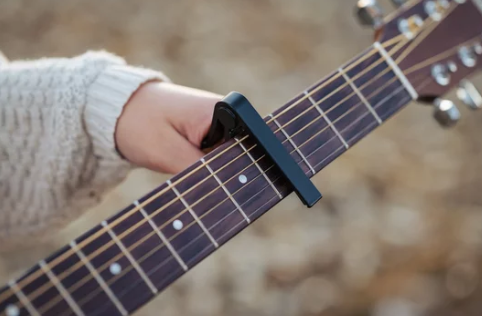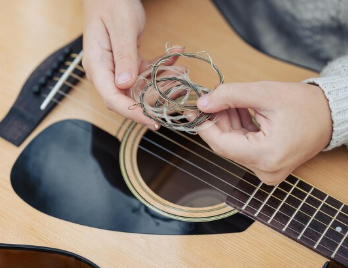What You Need To Know About Guitar Capo

The capo is one of the most versatile tools in a guitarist’s arsenal, yet many beginners overlook its potential. This small, clamp-like device allows you to instantly change the key of your guitar without altering your chord shapes. Whether you’re looking to match your voice to a song or make complex chords easier to play, this tool can be a game-changer.
In this guide, we’ll break down the essentials of using a capo and how you can maximize its use in your playing.
What is a Capo?
Is a clamp that fits across the neck of your guitar and presses down on all the strings at a specific fret. By doing so, it effectively shortens the length of the strings and raises the pitch of the notes played. This allows you to play in higher keys without needing to relearn new chord shapes.
For example, if you play a G chord but place this tool on the second fret, the chord will sound like an A, even though you’re using the same G chord shape.
Why Use a Capo?
- Key Changes Made Easy: If you want to sing a song that’s in a higher key but doesn’t know the new chord shapes, slap on a capo to change the pitch. This is particularly useful for singers who want to find the perfect key for their voice.
- Simplify Complex Chords: Some keys are tricky to play, filled with barre chords or awkward finger stretches. By using a capo, you can transpose those difficult keys to easier chord shapes.
- Unique Sound Textures: Using a capo creates a brighter, more vibrant sound by moving up the neck. It’s an easy way to give your playing a fresh, dynamic sound without changing much about your technique.
How to Place a Capo on Your Guitar
- Choose the Right Fret: The first step is deciding where to place your capo. The fret you choose will dictate how much higher your chords will sound. For example, placing the capo on the second fret raises the pitch by one whole step.
- Attach the Capo: Open the capo’s clamp and place it just behind the fret, not directly on top of it. You want the capo to be firm, but not so tight that it pulls your strings out of tune. The closer it is to the fret wire without touching it, the better.
- Check Your Tuning: After placing the capo, play a few chords or notes to make sure the strings are ringing clearly and your guitar remains in tune. If it sounds off, adjust the capo’s position or pressure.
Capo Fret Position and Corresponding Keys
Here’s a quick guide to what key your chords will sound like when using a capo at different fret positions:
- No Capo: Standard key (e.g., G chord sounds like G)
- On 1st fret: All chords raised by a half step (e.g., G sounds like G#)
- On 2nd fret: All chords raised by a whole step (e.g., G sounds like A)
- On 3rd fret: One and a half steps (e.g., G sounds like A#)
- On 5th fret: Two and a half steps (e.g., G sounds like C)
- On 7th fret: Three and a half steps (e.g., G sounds like D)
This transposition can be applied to any chord shape, making a capo invaluable for playing in different keys without memorizing tons of new chords.
Common Capo Mistakes (and How to Avoid Them)
- Misplacing the Capo: If you place it too far away from the fret, it can cause buzzing or deadened notes. Always make sure the capo is snugly positioned just behind the fret.
- Overtightening: This tool can apply too much pressure, pulling the strings sharp and causing tuning issues. If you’re struggling with this, try a capo with adjustable tension to get just the right fit.
- Neglecting Tuning: Always check your guitar’s tuning after applying a capo. Even small changes in string tension can cause your guitar to go out of tune, especially on the higher frets.
Practical Applications for Using a Capo
- Playing with Others: If you’re jamming with a group and the song is in a key that’s difficult for you, use a capo to transpose your chords to easier ones while staying in key with the band.
- Fingerstyle Playing: Capos can add richness to fingerstyle playing, especially in open tunings. By moving the capo higher on the neck, you can experiment with new tonal colors and harmonics that you wouldn’t get from standard tuning positions.
- Creating Variations: If you’re performing a cover song and want to put your own spin on it, use a capo to change the song’s key and feel. Even a simple chord progression can sound fresh and different when played higher up the neck.
Final Thoughts
The guitar capo is a simple yet powerful tool that can open up a world of musical possibilities. Whether you’re a beginner just getting comfortable with chords or an experienced player looking for fresh inspiration, the capo is a must-have accessory. Practice using it regularly, experiment with different fret positions, and you’ll find it’s an invaluable tool in your playing.
If you’re interested in learning an instrument, at Real Brave, we offer an incredible experience like no other place in music lessons for kids and adults by guiding them from the beginning stages of getting to know an instrument all the way through performing for family and friends on stage. Our instructors come from all over the world, bringing extensive experience on a wide range of instruments. Click below and book a free lesson with us!

Author: Daniel Powers Jr, the founder of Real Brave™, serves as the chief inspiration to thousands of students in the Real Brave music instruction program. He’s also the visionary behind PracticePad™, an online platform for live one-on-one online music lessons, lesson tracking, and scheduling. Beyond his entrepreneurial pursuits, Daniel leads a non-profit organization that provides formerly homeless children with access to music education, making a profound impact on their lives. His unwavering dedication to music, innovation, and education continues to inspire individuals to reach their fullest potential while creating positive change in communities. Follow Real Brave on all the socials:
youtube.com/@realbraveinc
twitter.com/realbraveinc
https://www.tiktok.com/@realbraveinc
instagram.com/realbraveaudio
facebook.com/realbraveinc





